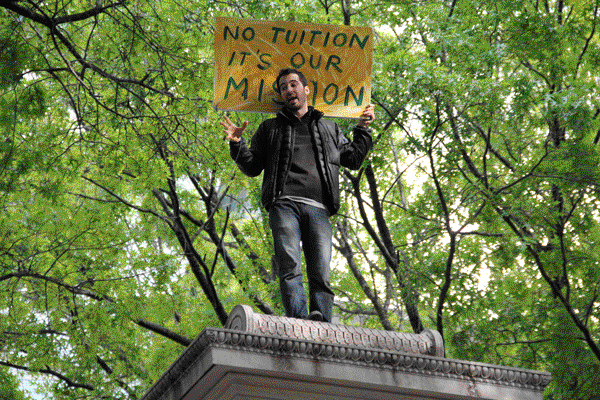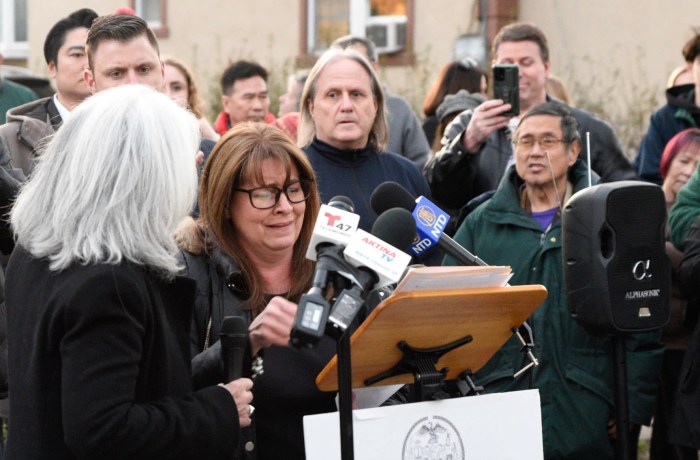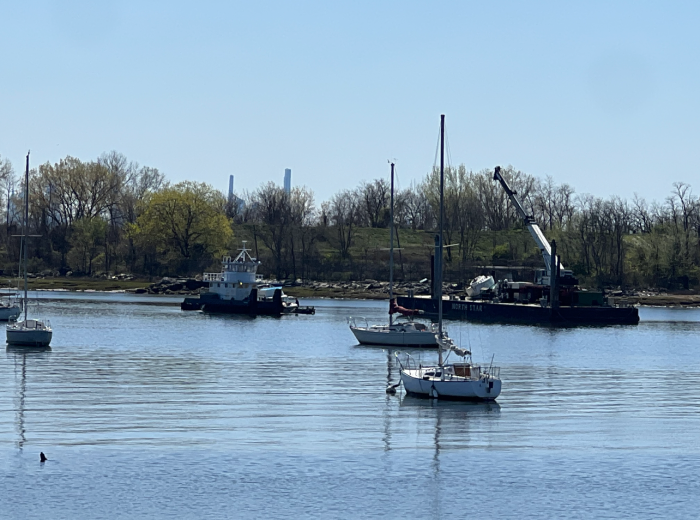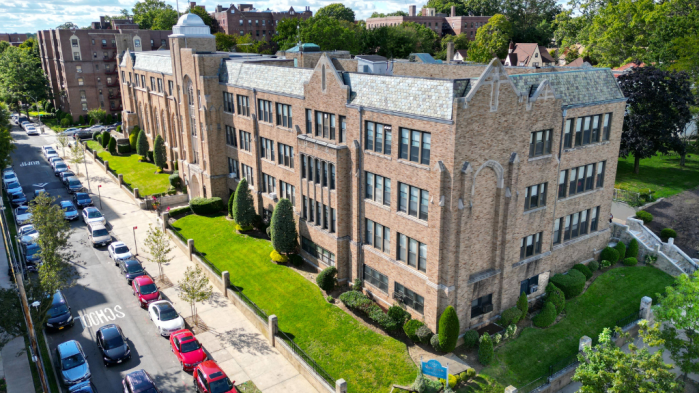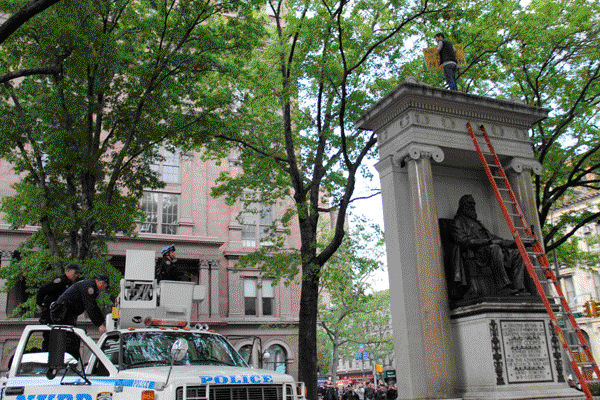 [/media-credit]
[/media-credit]
- Because their ladder was too short, police had to get a cherry picker to remove Jesse Kreuzer, a Cooper Union graduate student, from atop the Peter Cooper monument on the afternoon of Thurs., April 26. Kreuzer was protesting Cooper Union’s announced intention to charge tuition for graduate students. It took them an hour and a half to get him down.
BY ALBERT AMATEAU | Friends of Cooper Union — a coalition of students and alumni — gathered in the historic Great Hall on Astor Place last week to protest the elite school’s decision to break with its 110-year-old tradition of free tuition for all students.
A few hours before the Thurs., April 26, forum, Cooper Union students joined an Occupy Wall Street demonstration that attracted 300 people to Peter Cooper Park to protest the staggering national student loan debt.
Two days before the forum, the school’s president, Jamshed Bharucha, announced that Cooper Union would begin charging tuition to graduate students entering in September 2013.
The tuition decision applied only to entering graduate students, but the school’s board of trustees made no other commitment about undergraduates beyond saying that students entering the schools of Engineering, Architecture, Art and Humanities and Social Sciences by 2017 would not be charged tuition.
Last fall, Bharucha, who became president in July, said Cooper Union had to trim more than $20 million from its annual operating deficits by 2018.
Among the proposed changes at Cooper Union is a master’s degree graduate program to start as early as next year combining the school’s specialties in engineering and art.
Founded in 1859 by the industrialist and inventor Peter Cooper to provide free education for working-class youth, The Cooper Union for the Advancement of Science and Art has not charged tuition for any degree program since 1902.
Henry Chapman, a graduate student and an organizer of Friends of Cooper Union, said the “summit meeting” on April 26 attracted 300 students, alumni and teachers dedicated to preserving free tuition at the school.
“Over the last several months we’ve worked on a document showing a financial way forward for Copper Union with ideas protecting and advancing the mission of the college,” Chapman said.
A panel of 15 alumni, faculty and students led the April 26 meeting, which was based on a 30-page report, “The Way Forward,” on financial and policy issues at Cooper Union.
Among the suggestions was deferring administrative salaries, including part of Bharucha’s annual salary estimated at $700,000. Bharucha had previously announced that he would donate 5 percent of his salary to the Cooper Union annual operating fund.
Nevertheless, the report suggested that the three highest-paid administrative offices defer a third of their salaries until 2018 when the rent from the ground lease under the Chrysler Building — a significant part of the school’s endowment — is due to increase from $7 million to $32.5 million. The Chrysler ground lease is due to rise even higher in subsequent years.
The report also suggested that a $2 million reduction in expenses and an addition of $1 million in revenue should be an immediate goal to preserve free tuition.
Cooper Union should also give up its lease of space it does not own in 30 Cooper Square, saving $710,231 per year, the report says. Another recommendation is that space in school-owned buildings should be found for the office of the treasurer as well as development, admissions and records, student services, alumni outreach and financial aid offices.
Adriana Farmiga, an alumna of the School of Art and programming director at La MaMa Gallery, suggested that a gala auction showcasing the work of Cooper alumni, faculty and staff could raise significant funds. Farmiga and several other alumni have been working on the idea for the past few months.
“We are aware we will not solve all Cooper’s financial problems with this auction but it’s a great start and the right first step,” she said. Since 2001 Cooper Union has provided the president with housing at the school’s Stuyvesant Fish House, at 21 Stuyvesant St.
“There are benefits to providing a presidential residence so close to Cooper Union, particularly for fundraising purposes. However, there may be equally compelling reasons for the president to consider abdicating the property,” the report says.
A return to the past was another alternative. The first floor of the Foundation Building, which had shopping arcades until the turn of the 20th century, currently has 1,500 square feet of library space. It could return to revenue-producing commercial use if another space for the library were located, the report noted.
Members of the panel said that it was time Cooper Union also thought of “growing down” into the neighborhood where it is located and into the local schools.
Partnering with St. Mark’s Bookshop, located in a school-owned building, could keep the imperiled bookshop afloat, the report said. Cooper Union, with a premier School of Art, should also offer classes in city schools that are lacking funds for an arts curriculum.
Students recently organized the Cooper Union Volunteer Tutoring Initiative to tutor local students in the arts and sciences. The report says the school should work to establish links with other organizations to promote the effort.
Cooper Union has stopped its contributions to the Outreach and the Saturday Programs in the School of Art.
“Cooper Union saves a tiny fraction of its budget by eliminating its annual donations to the programs, but in doing so it sacrifices a truly meaningful link between The Cooper Union, the city of New York and Peter Cooper’s original vision,” the report says.
Alan Lundgard, the junior at Cooper Union who issued a hoax news release on April 16 that the school would lease its newly completed
Engineering Building to New York University, attended the April 26 forum. But he was unable to speak because he had irritated his throat by shouting at the demonstration a few hours earlier. However, a fellow student read his statement to great acclaim.



